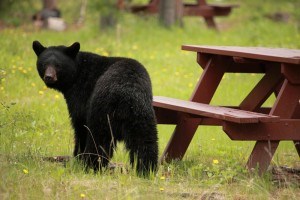
It’s been a deadly year for black bears in Jasper.
Seventeen of the animals are dead this season as a result of interactions with humans: two that were threats to humans were destroyed by Parks Canada staff, six have been hit and killed along highways and nine have been killed on the train tracks.
According to Parks Canada biologist John Wilmshurst, that’s more human-related bear deaths than the park has seen since the 1970s, when garbage in Jasper wasn’t managed like it is today.
Decades ago bears were much more common in town and campgrounds because human garbage wasn’t being strictly managed. Back then more than a dozen bear deaths a year was common, but since garbage collection and disposal methods have improved, such numbers are essentially unheard of.
Wilmshurst said a big reason so many bears have been killed this year is because their primary food source isn’t readily available.
“Food really motivates bears, it’s really what they do, so [the deaths are] probably food related,” he said.
“The berry crop, which is the main food source for bears this time of year, certainly in the Three Valley Confluence, hasn’t really been great at all. In fact you could say it’s failed.”
During this time of year, a bear’s diet can be composed 75 per cent or more of berries. With a hot, dry summer, that food source was more or less non-existent this year, so Wilmshurst said bears are looking for alternatives wherever possible.
An easy place to find those alternatives is in campgrounds, where visitors might not recognize how crucial proper food management is, and along the side of highways, where the vegetation is like bear snack food. An even easier place is the train tracks running through the park, where spilled grain from grain cars often accumulates.
“That’s a very efficient food source for bears: grain is very high in nutrition, so they’re clearly motivated by that,” Wilmshurst said.
Concerned Jasperites have been raising the alarm for years about grain spills on the tracks.
And as recently as last April, Jill Seaton of the Jasper Environmental Association criticized the Canadian National Railway for not using its specialized vacuum truck for cleaning up spills in town.
At the time, Warren Chandler, a spokesperson for CN, said the truck was removed about a year ago “due to the fact that there was no requirement for its use in the previous years it was based in Jasper.”
CN reports wildlife strikes and grain spills to Parks, but cleaning up spills is entirely the prerogative of the rail company.
“CN is it’s own entity, [the tracks are] their property; their right of way. They manage that,” Wilmshurst said.
While Parks can do little to combat grain spills on the tracks, it’s working hard to ensure as few bears as possible are killed. Wilmshurst said the organization is constantly pumping out bear awareness messages in its campgrounds and through its visitor engagement team. It also keeps reduced speed zones on the road, and is in the middle of a comprehensive study in Banff that looks at ways to keep bears off train tracks through fencing and electric mats.
But Jasper residents can help out as well. Since berries are scarce this year, bears will be even more likely to forage in town, and residents’ fruit and berry plants are a prime target. Wilmshurst asked that anyone with such plants in their yard vigilantly monitor them, and harvest the fruit as soon as possible.
Trevor Nichols
[email protected]
